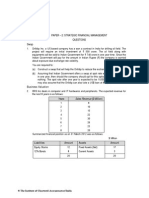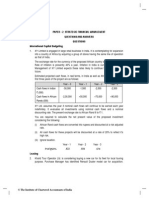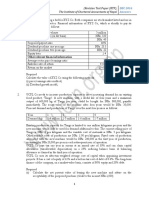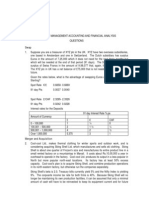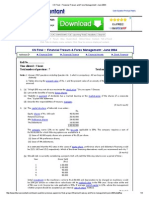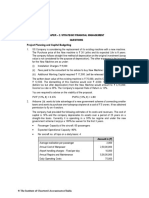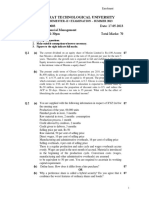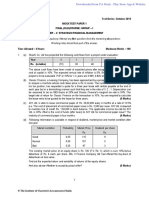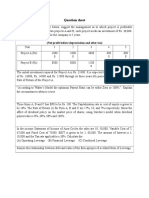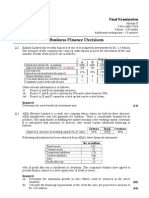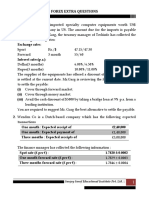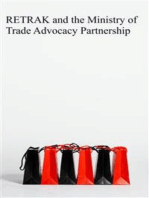© The Institute of Chartered Accountants of India
© The Institute of Chartered Accountants of India
Uploaded by
amitmdeshpandeCopyright:
Available Formats
© The Institute of Chartered Accountants of India
© The Institute of Chartered Accountants of India
Uploaded by
amitmdeshpandeOriginal Description:
Original Title
Copyright
Available Formats
Share this document
Did you find this document useful?
Is this content inappropriate?
Copyright:
Available Formats
© The Institute of Chartered Accountants of India
© The Institute of Chartered Accountants of India
Uploaded by
amitmdeshpandeCopyright:
Available Formats
PAPER 2: STRATEGIC FINANCIAL MANAGEMENT
QUESTIONS
Replacement Decision
1. Trouble Free Solutions (TFS) is an authorized service center of a reputed domestic air
conditioner manufacturing company. All complaints/ service related matters of Air
conditioner are attended by this service center. The service center employs a large
number of mechanics, each of whom is provided with a motor bike to attend the
complaints. Each mechanic travels approximately 40000 kms per annuam. TFS decides
to continue its present policy of always buying a new bike for its mechanics but wonders
whether the present policy of replacing the bike every three year is optimal or not. It is of
believe that as new models are entering into market on yearly basis, it wishes to
consider whether a replacement of either one year or two years would be better option
than present three year period. The fleet of bike is due for replacement shortly in near
future.
The purchase price of latest model bike is ` 55,000. Resale value of used bike at current
prices in market is as follows:
Period `
1 Year old 35,000
2 Year old 21,000
3 Year old 9,000
Running and Maintenance expenses (excluding depreciation) are as follows:
Year Road Taxes Insurance etc.
(`)
Petrol Repair Maintenance etc.
(`)
1 3,000 30,000
2 3,000 35,000
3 3,000 43,000
Using opportunity cost of capital as 10% you are required to determine optimal
replacement period of bike.
Merger &Acquisition
2. Hanky Ltd. and Shanky Ltd. operate in the same field, manufacturing newly born babiess
clothes. Although Shanky Ltd. also has interest in communication equipments, Hanky
Ltd. is planning to take over Shanky Ltd. and the shareholders of Shanky Ltd. do not
regard it as a hostile bid.
The following information is available about the two companies.
The Institute of Chartered Accountants of India
PAPER 2 : STRATEGIC FINANCIAL MANAGEMENT
59
Hanky Ltd. Shanky Ltd.
Current earnings ` 6,50,00,000 ` 2,40,00,000
Number of shares 50,00,000 15,00,000
Percentage of retained earnings 20% 80%
Return on new investment 15% 15%
Return required by equity shareholders 21% 24%
Dividends have just been paid and the retained earnings have already been reinvested in
new projects. Hanky Ltd. plans to adopt a policy of retaining 35% of earnings after the
takeover and expects to achieve a 17% return on new investment.
Saving due to economies of scale are expected to be ` 85,00,000 per annum.
Required return to equity shareholders will fall to 20% due to portfolio effects.
Requirements
(a) Calculate the existing share prices of Hanky Ltd. and Shanky Ltd.
(b) Find the value of Hanky Ltd. after the takeover
(c) Advise Hanky Ltd. on the maximum amount it should pay for Shanky Ltd.
3. A Ltd.s (Acquirer company) equity capital is ` 2,00,00,000. Both A Ltd. and T Ltd.
(Target Company) have arrived at an understanding to maintain debt equity ratio at 0.30 :
1 of the merged company. Pre-merger debt outstanding of A Ltd. stood at ` 20,00,000
and T Ltd at ` 10,00,000 and marketable securities of both companies stood at
` 40,00,000.
You are required to calculate total fund requirements of A Ltd. to acquire T Ltd. against
cash payment at mutually agreed price of ` 65,00,000.
Index Futures
4. BSE 5000
Value of portfolio `10,10,000
Risk free interest rate 9% p.a.
Dividend yield on Index 6% p.a.
Beta of portfolio 1.5
We assume that a future contract on the BSE index with four months maturity is used to
hedge the value of portfolio over next three months. One future contract is for delivery of
50 times the index.
Based on the above information calculate:
(i) Price of future contract.
(ii) The gain on short futures position if index turns out to be 4,500 in three months.
The Institute of Chartered Accountants of India
FINAL EXAMINATION: NOVEMBER, 2013
60
(iii) Value of Portfolio using CAPM.
5. Suppose current price of an index is `13,800 and yield on index is 4.8% (p.a.). A 6-
month future contract on index is trading at `14,340.
Assuming that Risk Free Rate of Interest is 12%, show how Mr. X (an arbitrageur) can
earn an abnormal rate of return irrespective of outcome after 6 months. You can assume
that after 6 months index closes at ` 10,200 and ` 15,600 and 50% of stock included in
index shall pay divided in next 6 months.
Also calculate implied risk free rate.
Portfolio Management
6. Following data is related to Company X, Market Index and Treasury Bonds for the current
year and last 4 years:
Year Company X Market Index
Average
Share Price
(P)
Dividend
Per Share
(D)
Average
Market
Index
Market
Dividend
Yield
Return on
Treasury
Bonds
2009 ` 139 ` 7.00 1300 3% 7%
2010 ` 147 ` 8.50 1495 5% 9%
2011 ` 163 ` 9.00 1520 5.5% 8%
2012 ` 179 ` 9.50 1640 4.75% 8%
2013 (Current Year) ` 203.51 ` 10.00 1768 5.5% 8%
With the above data estimate the beta of Company Xs share.
7. The rates of return on the security of Company X and market portfolio for 10 periods are
given below:
Period Return of Security X (%) Return on Market Portfolio (%)
1 20 22
2 22 20
3 25 18
4 21 16
5 18 20
6 5 8
7 17 6
8 19 5
9 7 6
10 20 11
The Institute of Chartered Accountants of India
PAPER 2 : STRATEGIC FINANCIAL MANAGEMENT
61
(i) What is the beta of Security X?
(ii) What is the characteristic line for Security X?
Foreign Exchange Management
8. Columbus Surgicals Inc. is based in US, has recently imported surgical raw materials
from the UK and has been invoiced for 480,000, payable in 3 months. It has also
exported surgical goods to India and France.
The Indian customer has been invoiced for 138,000, payable in 3 months, and the
French customer has been invoiced for 590,000, payable in 4 months.
Current spot and forward rates are as follows:
/ US$
Spot: 0.9830 0.9850
Three months forward: 0.9520 0.9545
US$ /
Spot: 1.8890 1.8920
Four months forward: 1.9510 1.9540
Current money market rates are as follows:
UK: 10.0% 12.0% p.a.
France: 14.0% 16.0% p.a.
USA: 11.5% 13.0% p.a.
You as Treasury Manager are required to show how the company can hedge its foreign
exchange exposure using Forward markets and Money markets hedge and suggest
which the best hedging technique is.
9. ABN-Amro Bank, Amsterdam, wants to purchase `15 million against US$ for funding
their Vostro account with Canara Bank, New Delhi. Assuming the inter-bank, rates of
US$ is `51.3625/3700, what would be the rate Canara Bank would quote to ABN-Amro
Bank? Further, if the deal is struck, what would be the equivalent US$ amount.
Mutual Fund
10. A Mutual Fund Co. has the following assets under it on the close of business as on:
1
st
February 2012 2
nd
February 2012
Company No. of Shares Market price per share Market price per share
` `
L Ltd 20,000 20.00 20.50
M Ltd 30,000 312.40 360.00
The Institute of Chartered Accountants of India
FINAL EXAMINATION: NOVEMBER, 2013
62
N Ltd 20,000 361.20 383.10
P Ltd 60,000 505.10 503.90
Total No. of Units 6,00,000
(i) Calculate Net Assets Value (NAV) of the Fund.
(ii) Following information is given:
Assuming one Mr. A, submits a cheque of ` 30,00,000 to the Mutual Fund and the Fund
manager of this company purchases 8,000 shares of M Ltd; and the balance amount is
held in Bank. In such a case, what would be the position of the Fund?
(iii) Find new NAV of the Fund as on 2nd February 2012.
Dividend Decision
11. X Ltd., has 8 lakhs equity shares outstanding at the beginning of the year 2012. The
current market price per share is ` 120. The Board of Directors of the company is
contemplating ` 6.4 per share as dividend. The rate of capitalisation, appropriate to the
risk-class to which the company belongs, is 9.6%:
(i) Based on M-M Approach, calculate the market price of the share of the company,
when the dividend is (a) declared; and (b) not declared.
(ii) How many new shares are to be issued by the company, if the company desires to
fund an investment budget of ` 3.20 crores by the end of the year assuming net
income for the year will be ` 1.60 crores?
Leasing
12. Sundaram Ltd. discounts its cash flows at 16% and is in the tax bracket of 35%. For the
acquisition of a machinery worth `10,00,000, it has two options either to acquire the
asset by taking a bank loan @ 15% p.a. repayable in 5 yearly installments of `2,00,000
each plus interest or to lease the asset at yearly rentals of `3,34,000 for five (5) years. In
both the cases, the instalment is payable at the end of the year. Depreciation is to be
applied at the rate of 15% using written down value (WDV) method. You are required to
advise which of the financing options is to be exercised and why.
Year 1 2 3 4 5
P.V factor @16% 0.862 0.743 0.641 0.552 0.476
Security Valuation
13. Calculate the value of share from the following information:
Profit of the company ` 290 crores
Equity capital of company ` 1,300 crores
Par value of share ` 40 each
Debt ratio of company 27
The Institute of Chartered Accountants of India
PAPER 2 : STRATEGIC FINANCIAL MANAGEMENT
63
Long run growth rate of the company 8%
Beta 0.1; risk free interest rate 8.7%
Market returns 10.3%
Capital expenditure per share ` 47
Depreciation per share ` 39
Change in Working capital ` 3.45 per share
Money Market Instrument
14. Nominal value of 10% bonds issued by a company is `100. The bonds are redeemable at
`110 at the end of year 5.
Determine the value of the bond if required yield is (i) 5%, (ii) 5.1%, (iii) 10% and (iv)
10.1%.
Economic Value Added
15. Consider the following operating information gathered from 3 companies that are
identical except for their capital structures:
P Ltd. Q Ltd. R Ltd.
Total invested capital 100,000 100,000 100,000
Debt/assets ratio 0.80 0.50 0.20
Shares outstanding 6,100 8,300 10,000
Before-tax cost of debt 14% 12% 10%
Cost of equity 26% 22% 20%
Operating income, (EBIT) 25,000 25,000 25,000
Net Income 8,970 12,350 14,950
Tax rate 35% 35% 35%
(a) Compute the weighted average cost of capital, WACC, for each firm.
(b) Compute the Economic Value Added, EVA, for each firm.
(c) Based on the results of your computations in part b, which firm would be considered
the best investment? Why?
(d) Assume the industry P/E ratio generally is 15 . Using the industry norm, estimate
the price for each share.
(e) What factors would cause you to adjust the P/E ratio value used in part d so that it
is more appropriate?
The Institute of Chartered Accountants of India
FINAL EXAMINATION: NOVEMBER, 2013
64
Indian Capital Market
16. Abhishek Ltd. has a surplus cash of `90 lakhs and wants to distribute 30% of it to the
shareholders. The Company decides to buyback shares. The Finance Manager of the
Company estimates that its share price after re-purchase is likely to be 10% above the
buyback price; if the buyback route is taken. The number of shares outstanding at
present is 10 lakhs and the current EPS is `3.
You are required to determine:
(a) The price at which the shares can be repurchased, if the market capitalization of the
company should be ` 200 lakhs after buyback.
(b) The number of shares that can be re-purchased.
(c) The impact of share re-purchase on the EPS, assuming the net income is same.
17. A Mutual Fund is holding the following assets in ` Crores :
Investments in diversified equity shares 90.00
Cash and Bank Balances 10.00
100.00
The Beta of the portfolio is 1.1. The index future is selling at 4300 level. The Fund
Manager apprehends that the index will fall at the most by 10%. How many index futures
he should short for perfect hedging so that the portfolio beta is reduced to 1.00? One
index future consists of 50 units.
Substantiate your answer assuming the Fund Manager's apprehension will materialize.
Swap
18. A Inc. and B Inc. intend to borrow $200,000 and $200,000 in respectively for a time
horizon of one year. The prevalent interest rates are as follows:
Company Loan $ Loan
A Inc 5% 9%
B Inc 8% 10%
The prevalent exchange rate is $1 = 120.
They entered in a currency swap under which it is agreed that B Inc will pay A Inc @ 1%
over the Loan interest rate which the later will have to pay as a result of the agreed
currency swap whereas A Inc will reimburse interest to B Inc only to the extent of 9%.
Keeping the exchange rate invariant, quantify the opportunity gain or loss component of
the ultimate outcome, resulting from the designed currency swap.
The Institute of Chartered Accountants of India
PAPER 2 : STRATEGIC FINANCIAL MANAGEMENT
65
Commodity Futures
19. A company is long on 10 MT of copper @ ` 474 per kg (spot) and intends to remain so
for the ensuing quarter. The standard deviation of changes of its spot and future prices
are 4% and 6% respectively, having correlation coefficient of 0.75.
What is its hedge ratio? What is the amount of the copper future it should short to
achieve a perfect hedge?
20. Write a short note on
(a) How financial policy is linked to strategic management
(b) Zero date of a Project in project management
(c) Cross Border Leasing
(d) Offer for Sale
(e) External Commercial Borrowings (ECBs)
SUGGESTED ANSWERS/HINTS
1. In this question the effect of increasing running cost and decreasing resale value have to
be weighted upto against the purchase cost of bike. For this purpose we shall compute
Equivalent Annual Cost (EAC) of replacement in different years shall be computed and
compared.
Year Road
Taxes
(`)
Petrol
etc.
(`)
Total
(`)
PVF
@10%
PV
(`)
Cumulative
PV (`)
PV of
Resale
Price
(`)
Net
Outflow
(`)
1 3,000 30,000 33,000 0.909 29,997 29,997 31,815 (1,818)
2 3,000 35,000 38,000 0.826 31,388 61,385 17,346 44,039
3 3,000 43,000 46,000 0.751 34,546 95,931 6,759 89,172
Computation of EACs
Year Purchase
Price of Bike
(`)
Net Outflow
(`)
Total
Outflow
(`)
PVAF
@ 10%
EAC
(`)
1 55,000 (1,818) 53,182 0.909 58,506
2 55,000 44,039 99,039 1.735 57,083
3 55,000 89,172 1,44,172 2.486 57,993
Thus, from above table it is clear that EAC is least in case of 2 years, hence bike should
be replaced every two years.
The Institute of Chartered Accountants of India
FINAL EXAMINATION: NOVEMBER, 2013
66
2. (a) Existing share price of Hanky (P) Ltd.
g = r x b
r = 15%
b = 20%
g = 0.15 x 0.2
= 0.03
Ex dividend market value =
g
e
k
dividend s year' Next
=
0.03 0.21
x1.03 0.8 x 0 6,50,00,00
= ` 29,75,55,556
= ` 59.51 per share
Existing share price Shanky (P) Ltd.
g = r x b
= 0.15 x 0.8
= 0.12
Ex dividend market value =
g
e
k
dividend s year' Next
=
2,40,00,000 x 0.2x1.12
0.24 - 0.12
= ` 4,48,00,000
= ` 29.87 per share
(b) Value of Hanky Ltd. after the takeover
Care must be taken in calculating next years dividend and the subsequent growth
rate. Next years earnings are already determined, because both companies have
already reinvested their retained earnings at the current rate of return. In addition,
they will get cost savings of ` 85,00,000.
The dividend actually paid out at the end of next year will be determined by the new
35% retention and the future growth rate will take into account the increased return
on new investment.
Growth rate for combined firm, g = 0.17 x 0.35 = 0.0595
New cost of equity = 20%
The Institute of Chartered Accountants of India
PAPER 2 : STRATEGIC FINANCIAL MANAGEMENT
67
Next years earnings = ` 6,50,00,000 x 1.03 + ` 2,40,00,000 x 1.12 + ` 85,00,000
= ` 10,23,30,000
Next years dividend = ` 10,23,30,000 x 0.65
= ` 6,65,14,500
Market value =
6,65,14,500
0.20- 0.0595
`
= ` 47,34,12,811
(c) Maximum Hanky Ltd. should pay for Shanky Ltd.
Combined value = ` 47,34,12,811
Present Value of Hanky Ltd. = ` 29,75,55,556
= ` 17,58,57,255
3.
`
Debt capacity of merged company (2,00,00,000 0.30) 60,00,000
Less: Debt of A Ltd and T Ltd. 30,00,000
30,00,000
Add: Marketable securities of both companies 40,00,000
70,00,000
Since the combined liquidity of merged company shall remain comfortable, it shall be
feasible to pay cash for acquiring the T Ltd. against tentative price of ` 65,00,000.
4. (i) Current future price of the index = 5000 + 5000 (0.09-0.06)
12
4
= 5000+ 50= 5,050
Price of the future contract = ` 50 5,050 = ` 2,52,500
(ii) Hedge ratio = 1.5
2,52,500
10,10,000
= 6 contracts
Index after there months turns out to be 4500
Future price will be = 4500 + 4500 (0.09-0.06)
12
1
= 4,511.25
Therefore, Gain from the short futures position is = 6 (5050 4511.25) 50 = ` 1,61,625
(iii) To use CAPM we require risk-free rate of return, beta of portfolio and Market
Return. Since risk-free rate of return and beta of portfolio is given first we shall
calculate market return as follows:
Change in Index Value = 4500-5000 = -500
The Institute of Chartered Accountants of India
FINAL EXAMINATION: NOVEMBER, 2013
68
Return from Index =
100
5000
500 -
= -10% for 3 months
Dividend yield on index p.a. = 6% and for 3 months shall be 1.5%.
Thus return to investor for investment in index for three months= -10%+1.5% = -8.5%
Now we can use CAPM to compute expected return for 3 months:
Expected Return = R
f + (Rm Rf)
= 2.25% + 1.50(- 8.5 - 2.25%)
= 2.25% + 1.50 (-10.75%)
= -13.875%
The expected value of portfolio (without hedging) after 3 months will be:
` 10,10,000[1+(-0.13875)]= `8,69,862.25
The expected value of portfolio with hedging after 3 months will be:
= Expected Value of portfolio (without hedging) + Gain from the future Index
= `8,69,862.25 + `1,61,625 = `10,31,487.25
5. The fair price of the index future contract can calculated as follows:
FC = 13,800 + [(13,800 0.12
6
12
- 13,800 4.8% 0.50)]
= 13,800 + [828 331.20] = ` 14,296.80
Since presently index is trading at ` 14,340, hence it is overpriced.
To earn an abnormal rate of return, Mr. X shall take following steps:
1. Mr. X shall buy a portfolio which comprising of shares as index consisted of.
2. Mr. X shall go for short position on index future contract.
Now we shall calculate return to Mr. X under two given situations:
(i) Return of Mr. X, if index closes at ` 10,200
`
Profit from short position of futures (`14,340 `10,200) 4,140.00
Cash Dividend on Portfolio (`13,800 4.8% 0.5) 331.20
Loss on sale of portfolio (`10,200 `13,800) (3,600.00)
871.20
The Institute of Chartered Accountants of India
PAPER 2 : STRATEGIC FINANCIAL MANAGEMENT
69
(ii) Return of Mr. X if index closes at ` 15,600
`
Loss from short position in futures. (`14,340 `15,600) (1,260.00)
Cash dividend on portfolio 331.20
Profit on sale of underlying portfolio (`15,600 `13,800) 1,800.00
871.20
6 months Return
871.20
100
13,800
= 6.31%
Annualised Return = 6.31 2 = 12.63%
6. First of we shall calculate expected return from share of Company X
(i) Average annual capital gain (%)
Let g = average annual capital gain, then:
`203.51(1+g)
= `139
Then g = (203.51/139)
-1 = 0.10 i.e. 10%
(ii) Average annual dividend yield (%)
Year Dividend/Share Price Dividend Yield
2009 `7.00/`139 0.050
2010 `8.50/ `147 0.058
2011 `9.00/ `163 0.055
2012 `9.50/ `179 0.053
2013 (Current Year) `10.00/ `203.51 0.049
0.265
Average Yield = 0.265/5= 0.053 i.e. 5.3%
Thus with this data expected return of share of Company X can be given as follows:
E(rX) = Average Annual Capital Gain + Average Annual Dividend
= 10% + 5.3% = 15.3%
Then we shall calculate expected return from market index as follows:
(i) Average annual capital gain (%)
1300 (1+g)
= 1768
Then g = (203.51/139)
-1 = 0.08 i.e. 8%
The Institute of Chartered Accountants of India
FINAL EXAMINATION: NOVEMBER, 2013
70
(ii) Average annual dividend yield (%)
3% + 5% + 5.5% + 4.75% + 5.5% = 23.75%/5 = 4.75%
Thus expected return on Market Index E(rM) = 8% + 4.75% = 12.75%
Average annual risk-free rate of return
7% + 9% + 8% + 8% + 8% = 40%/5 = 8%
Now with the above information we compute Beta () of share company X using
CAPM as follows:
E(r
X) = rf + [E(rM) - rf]
15.3% = 8% + [12.75% - 8%]
= 1.54
7. (i)
Period
X
R
M
R
X
X
R R M
M
R R
( ) X
X
R R
( ) M
M
R R
( )
2
M
M
R R
1 20 22 5 10 50 100
2 22 20 7 8 56 64
3 25 18 10 6 60 36
4 21 16 6 4 24 16
5 18 20 3 8 24 64
6 -5 8 -20 -4 80 16
7 17 -6 2 -18 -36 324
8 19 5 4 -7 -28 49
9 -7 6 -22 -6 132 36
10 20 11 5 -1 -5 1
150 120 357 706
RX RM
) R R )( R (R M
M
X
X
2
M
M
) R R (
X R
= 15
M R
= 12
2
M =
n
R R
2
M M
=
10
706
= 70.60
The Institute of Chartered Accountants of India
PAPER 2 : STRATEGIC FINANCIAL MANAGEMENT
71
CovX M=
n
R R R R
M M X X
=
10
357
= 35.70
Betax =
M
2
M X
Cov
=
60 . 70
70 . 35
= 0.505
(ii)
X R = 15
M R
= 12
y = + x
15 = + 0.505 12
Alpha () = 15 (0.505 12)
= 8.94%
Characteristic line for security X = + RM
Where, RM = Expected return on Market Index
Characteristic line for security X = 8.94 + 0.505 RM
8. Exposure
Since Columbus has a receipt ( 138,000) and payment of ( 480,000) maturing at the
same time i.e. 3 months, it can match them against each other leaving a net liability of
342,000 to be hedged.
(i) Forward market hedge
Buy 3 months' forward contract accordingly, amount payable after 3 months will be
342,000 / 0.9520 = US$ 359,244
(ii) Money market hedge
To pay after 3 months' Columbus shall requires to borrow in US$ and translate to
and then deposit in .
For payment of 342,000 in 3 months (@2.5% interest) amount required to be
deposited now
( 342,000 1.025) = 333,658
With spot rate of 0.9830 the US$ loan needed will be = US$ 339,429.
Loan repayable after 3 months (@3.25% interest) will be = US$ 350,460.
In this case the money market hedge is a cheaper option.
Receipt
Amount to be hedged = 590,000
Now we Convert exchange rates to home currency
The Institute of Chartered Accountants of India
FINAL EXAMINATION: NOVEMBER, 2013
72
/ US$
Spot 0.5285 0.5294
4 months forward 0.5118 0.5126
(i) Forward market hedge
Sell 4 months' forward contract accordingly, amount receivable after 4 months
will be
( 590,000 / 0.5126) = US$ 1,150,995
(ii) Money market hedge
For money market hedge Columbus shall borrow in and then translate to
US$ and deposit in US$
For receipt of 590,000 in 4 months (@ 5.33% interest) amount required to be
borrowed now
(590,000 1.0533) = 560,144
With spot rate of 0.5294 the US$ deposit will be = US$ 1,058,073
deposit amount will increase over 3 months (@3.83% interest) will be = US$ 1,098,597
In this case, more will be received in US$ under the forward hedge.
9. Here Canara Bank shall buy US$ and credit ` to Vostro account of ABN-Amro Bank.
Canara Banks buying rate will be based on the Inter-bank Buying Rate (as this is the
rate at which Canara Bank can sell US$ in the Interbank market)
Accordingly, the Interbank Buying Rate of US$ will be ` 51.3625 (lower of two)
Equivalent of US$ for `15 million at this rate will be
=
51.3625
15,000,000
= US$ 2,92,041.86
10. (i) NAV of the Fund
=
` ` ` ` 4,00,000 93,72,000 72,24,000 3,03,06,000
6,00,000
+ + +
=
` 4,73,02,000
6,00,000
=` 78.8366 rounded to ` 78.84
(ii) The revised position of fund shall be as follows:
Shares No. of shares Price Amount (`)
L Ltd. 20,000 20.00 4,00,000
M Ltd. 38,000 312.40 1,18,71,200
The Institute of Chartered Accountants of India
PAPER 2 : STRATEGIC FINANCIAL MANAGEMENT
73
N Ltd. 20,000 361.20 72,24,000
P Ltd. 60,000 505.10 3,03,06,000
Cash 5,00,800
5,03,02,000
No. of units of fund = 6,00,000
30,00,000
78.8366
+ = 6,38,053
(iii) On 2
nd
February 2012, the NAV of fund will be as follows:
Shares No. of shares Price Amount (`)
L Ltd. 20,000 20.50 4,10,000
M Ltd. 38,000 360.00 1,36,80,000
N Ltd. 20,000 383.10 76,62,000
P Ltd. 60,000 503.90 3,02,34,000
Cash 5,00,800
5,24,86,800
NAV as on 2
nd
February 2012 =
` 5,24,86,800
6,38,053
= ` 82.26 per unit
11. Modigliani and Miller (M-M) Dividend Irrelevancy Model:
e
1 1
0
K 1
D P
P
+
+
=
Where,
Po = Existing market price per share i.e. ` 120
P1 = Market price of share at the year-end (to be determined)
D1 = Contemplated dividend per share i.e. ` 6.4
Ke = Capitalisation rate i.e. 9.6%.
(i) (a) Calculation of share price when dividend is declared:
e
1 1
0
K 1
D P
P
+
+
=
0.096 1
6.4 P
120
1
+
+
=
120 1.096 = P1 + 6.4
P1 = 120 1.096 6.4
= 125.12
The Institute of Chartered Accountants of India
FINAL EXAMINATION: NOVEMBER, 2013
74
(b) Calculation of share price when dividend is not declared:
e
1 1
0
K 1
D P
P
+
+
=
0.096 1
0 P
120
1
+
+
=
120 1.096 = P1 + 0
P1 = 131.52
(ii) Calculation of No. of shares to be issued:
(` in lakhs)
Particulars If dividend
declared
If dividend not
declared
Net Income 160 160
Less: Dividend paid 51.20 ------
Retained earnings 108.80 160
Investment budget 320 320
Amount to be raised by issue of new shares (i) 211.20 160
Market price per share (ii) 125.12 131.52
No. of new shares to be issued (ii) 1,68,797.95 1,21,654.50
Or say 1,68,798 1,21,655
12. Alternative I: Acquiring the asset by taking bank loan:
Years 1 2 3 4 5
(a) Interest (@15% p.a. on
opening balance)
150,000 120,000 90,000 60,000 30,000
Depreciation (@15%WDV) 150,000 127,500 108,375 92,119 78,301
300,000 247,500 198,375 152,119 108,301
(b) Tax shield (@35%) 105,000 86,625 69,431 53,242 37,905
Interest less Tax shield (a)-(b) 45,000 33,375 20,569 6,758 (-)7,905
Principal Repayment 2,00,000 2,00,000 2,00,000 2,00,000 2,00,000
Total cash outflow 2,45,000 2,33,375 2,20,569 2,06,758 1,92,095
Discounting Factor @ 16% 0.862 0.743 0.641 0.552 0.476
Present Value 2,11,190 1,73,398 1,41,385 1,14,130 91,437
The Institute of Chartered Accountants of India
PAPER 2 : STRATEGIC FINANCIAL MANAGEMENT
75
Total P.V of cash outflow = `731,540
Alternative II: Acquire the asset on lease basis
Year Lease Rentals
`
Tax Shield
@35%
Net Cash
Outflow
Discount
Factor
Present
Value
1 3,34,000 1,16,900 2,17,100 0.862 1,87,140
2 3,34,000 1,16,900 2,17,100 0.743 1,61,305
3 3,34,000 1,16,900 2,17,100 0.641 1,39,161
4 3,34,000 1,16,900 2,17,100 0.552 1,19,839
5 3,34,000 1,16,900 2,17,100 0.476 1,03,340
Present value of Total Cash out flow 7,10,785
Advice -By making Analysis of both the alternatives, it is observed that the present value
of the cash outflow is lower in alternative II by `20,755 (i.e. ` 7,31,540 ` 7,10,785)
Hence, it is suggested to acquire the asset on lease basis.
13. No. of Shares =
crores 40
crores 300 , 1
`
`
= 32.5 Crores
EPS =
shares No.of
PAT
EPS =
crores 5 . 32
crores 290 `
= ` 8.923
FCFE = Net income [(1-b) (capex dep) + (1-b) ( WC)]
FCFE = 8.923 [(1-0.27) (47-39) + (1-0.27) (3.45)]
= 8.923 [5.84 + 2.5185]
= 0.5645
Cost of Equity = Rf + (Rm Rf)
= 8.7 + 0.1 (10.3 8.7)
= 8.86%
Po =
g K
g) FCFE(1
e
+
=
0086 . 0
60966 . 0
08 . 0886 . 0
) 08 . 1 ( 5645 . 0
=
= ` 70.89
The Institute of Chartered Accountants of India
FINAL EXAMINATION: NOVEMBER, 2013
76
14. Case (i) Required yield rate = 5%
Year Cash Flow` DF (5%) Present Value `
1-5 10 4.3295 43.295
5 110 0.7835 86.185
Value of bond 129.48
Case (ii) Required yield rate = 5.1%
Year Cash Flow` DF (5.1%) Present Value `
1-5 10 4.3175 43.175
5 110 0.7798 85.778
Value of bond 128.953
Case (iii) Required yield rate = 10%
Year Cash Flow` DF (10%) Present Value `
1-5 10 3.7908 37.908
5 110 0.6209 68.299
Value of bond 106.207
Case (iv) Required yield rate = 10.1%
Year Cash Flow` DF (10.1%) Present Value `
1-5 10 3.7811 37.811
5 110 0.6181 67.991
Value of bond 105.802
15. (a) WACCP = [14.0%(1 - 0.35)](0.80) + 26.0%(0.20) = 12.48%
WACCQ = [12.0%(1 - 0.35)](0.50) + 22.0%(0.50) = 14.90%
WACCR = [10.0%(1 - 0.35)](0.20) + 20.0%(0.80) = 17.30%
(b) EVA = EBIT(1 - T) - (WACC x Invested capital)
EVAP = 25,000(1 - 0.35) - (0.1248 x 100,000)
= 16,250 - 12,480
= 3,770
EVA
Q = 25,000(1 - 0.35) - (0.1490 x 100,000)
= 16,250 - 14,900
= 1,350
The Institute of Chartered Accountants of India
PAPER 2 : STRATEGIC FINANCIAL MANAGEMENT
77
EVAR = 25,000(1 - 0.35) - (0.1730 x 100,000)
= 16,250 - 17,300
= -1,050
(c) EVA
P > EVAQ > EVAR; Thus, P Ltd. would be considered the best investment. The
result should have been obvious, given that the firms have the same EBIT, but
WACCP < WACCQ < WACCR.
(d) P Ltd. Q Ltd. R Ltd.
EBIT 25,000 25,000 25,000
Interest
a
(11,200) ( 6,000) ( 2,000)
Taxable income 13,800 19,000 23,000
Tax (35%) ( 4,830) ( 6,650) ( 8,050)
Net income 8,970 12,350 14,950
Shares 6,100 8,300 10,000
EPS 1.470 1.488 1.495
Stock price: P/E = 15x 22.05 22.32 22.43
a
InterestP = 100,000(0.80) x 0.14 = 11,200
InterestQ = 100,000(0.50) x 0.12 = 6,000
InterestR = 100,000(0.20) x 0.10 = 2,000
(e) Given the three firms have substantially different capital structures, we would
expect that they also have different degrees of financial risk. Therefore, we might
want to adjust the P/E ratios to account for the risk differences.
16. (a) Let P be the buyback price decided by Abhishek Ltd.
Market Capitalisation After Buyback:
1.1 P (Original Shares Shares Bought back)
= )
P
lakhs 90 of 30%
- Lakhs (10 P 1.1
= 11 Lakhs x P 27 lakhs x 1.1
= 11 lakhs x P 29.7 lakhs
Market capitalization rate after buyback is 200 lakhs.
Thus, we have:
11 Lakhs x P 29.7 lakhs = `200 lakhs
or 11P = 200 + 29.7
The Institute of Chartered Accountants of India
FINAL EXAMINATION: NOVEMBER, 2013
78
or P = 88 . 20
11
7 . 229
` =
(b) Number of shares to be bought back:
) ly Approximae ( lakhs 29 . 1
88 . 20
Lakhs 27
= =
(c) New Equity Shares
= (10 1.29) lakhs = 8.71 lakhs
EPS = 44 . 3 . Rs
L 71 . 8
L 30
lakhs 71 . 8
lakhs 10 3
= =
Thus EPS of Abhishek Ltd., increases to `3.44
17. Number of index future to be sold by the Fund Manager is:
1.1 90,00,00,000
4,300 50
= 4,605
Justification of the answer:
Loss in the value of the portfolio if the index falls by 10% is
=
10(1.10)
90 Crore
100
` =
11
x 90 Crore
100
`
= ` 9.90 Crore.
Gain by short covering of index future is:
0.1 4,300 50 4,605
1,00,00,000
= 9.90 Crore
This justifies the answer cash is not part of the portfolio.
18.
Opportunity gain of A Inc under currency
swap
Receipt Payment Net
Interest to be remitted to B. Inc in $
2,00,0009%=$18,000
Converted into ($18,000120)
21,60,000
Interest to be received from B. Inc in $
converted into Y
(6%$2,00,000 120)
14,40,000 -
Interest payable on Y loan - 12,00,000
14,40,000 33,60,000
Net Payment 19,20,000 -
33,60,000 33,60,000
The Institute of Chartered Accountants of India
PAPER 2 : STRATEGIC FINANCIAL MANAGEMENT
79
$ equivalent paid 19,20,000 (1/120) $16,000
Interest payable without swap in $ $18,000
Opportunity gain in $ $ 2,000
Opportunity gain of B inc under currency
swap
Receipt Payment Net
Interest to be remitted to A. Inc in ($
2,00,000 6%)
$12,000
Interest to be received from A. Inc in Y
converted into $ =21,60,000/120
$18,000
Interest payable on $ loan@10% - $20,000
$18,000 $32,000
Net Payment $14,000
$32,000
-
$32,000
Y equivalent paid $14,000 X 120 16,80,000
Interest payable without swap in
($2,00,000 X 120X8%)
19,20,000
Opportunity gain in Y 2,40,000
Alternative Solution
Cash Flows of A Inc
(i) At the time of exchange of principal amount
Transactions Cash Flows
Borrowings $2,00,000 x 120 + 240,00,000
Swap - 240,00,000
Swap +$2,00,000
Net Amount +$2,00,000
(ii) At the time of exchange of principal amount
Transactions Cash Flows
Interest to the lender 240,00,000X5% 12,00,000
Interest Receipt from B Inc. 2,00,000X120X6% 14,40,000
Net Saving (in $) 2,40,000/120 $2,000
Interest to B Inc. $2,00,000X9% -$18,000
Net Interest Cost -$16,000
The Institute of Chartered Accountants of India
FINAL EXAMINATION: NOVEMBER, 2013
80
A Inc. used $2,00,000 at the net cost of borrowing of $16,000 i.e. 8%. If it had not
opted for swap agreement the borrowing cost would have been 9%. Thus there is
saving of 1%.
Cash Flows of B Inc
(i) At the time of exchange of principal amount
Transactions Cash Flows
Borrowings + $2,00,000
Swap - $2,00,000
Swap $2,00,000X120 +240,00,000
Net Amount +240,00,000
(ii) At the time of exchange of principal amount
Transactions Cash Flows
Interest to the lender $2,00,000X10% - $20,000
Interest Receipt from A Inc. +$18,000
Net Saving (in ) -$2,000X120 - 2,40,000
Interest to A Inc. $2,00,000X6%X120 - 14,40,000
Net Interest Cost - 16,80,000
B Inc. used 240,00,000 at the net cost of borrowing of 16,80,000 i.e. 7%. If it had
not opted for swap agreement the borrowing cost would have been 8%. Thus there
is saving of 1%.
19. The optional hedge ratio to minimize the variance of Hedgers position is given by:
H=
S
F
Where
S= Standard deviation of S
F=Standard deviation of F
= coefficient of correlation between S and F
H= Hedge Ratio
S = change in Spot price.
F= change in Future price.
The Institute of Chartered Accountants of India
PAPER 2 : STRATEGIC FINANCIAL MANAGEMENT
81
Accordingly
H = 0.75 x
0.04
0.06
= 0.5
No. of contract to be short = 10 x 0.5 = 5
Amount = 5000 x ` 474 = ` 23,70,000
20. (a) The success of any business is measured in financial terms. Maximising value to
the shareholders is the ultimate objective. For this to happen, at every stage of its
operations including policy-making, the firm should be taking strategic steps with
value-maximization objective. This is the basis of financial policy being linked to
strategic management.
The linkage can be clearly seen in respect of many business decisions. For
example:
(i) Manner of raising capital as source of finance and capital structure are the
most important dimensions of strategic plan.
(ii) Cut-off rate (opportunity cost of capital) for acceptance of investment
decisions.
(iii) Investment and fund allocation is another important dimension of interface of
strategic management and financial policy.
(iv) Foreign Exchange exposure and risk management.
(v) Liquidity management
(vi) A dividend policy decision deals with the extent of earnings to be distributed
and a close interface is needed to frame the policy so that the policy should be
beneficial for all.
(vii) Issue of bonus share is another dimension involving the strategic decision.
Thus from above discussions it can be said that financial policy of a company
cannot be worked out in isolation to other functional policies. It has a wider appeal
and closer link with the overall organizational performance and direction of growth.
(b) Zero Date of a Project means a date is fixed from which implementation of the
project begins. It is a starting point of incurring cost. The project completion period
is counted from the zero date. Pre-project activities should be completed before
zero date. The pre-project activities should be completed before zero date. The pre-
project activities are:
a. Identification of project/product
b. Determination of plant capacity
c. Selection of technical help/collaboration
d. Selection of site.
The Institute of Chartered Accountants of India
FINAL EXAMINATION: NOVEMBER, 2013
82
e. Selection of survey of soil/plot etc.
f. Manpower planning and recruiting key personnel
g. Cost and finance scheduling.
(c) Cross-border leasing is a leasing agreement where lessor and lessee are situated in
different countries. This raises significant additional issues relating to tax avoidance
and tax shelters. It has been widely used in some European countries, to arbitrage
the difference in the tax laws of different countries.
Cross-border leasing have been in practice as a means of financing infrastructure
development in emerging nations. Cross-border leasing may have significant
applications in financing infrastructure development in emerging nations - such as
rail and air transport equipment, telephone and telecommunications, equipment,
and assets incorporated into power generation and distribution systems and other
projects that have predictable revenue streams.
A major objective of cross-border leases is to reduce the overall cost of financing
through utilization by the lessor of tax depreciation allowances to reduce its taxable
income, The tax savings are passed through to the lessee as a lower cost of
finance. The basic prerequisites are relatively high tax rates in the lessor's country,
liberal depreciation rules and either very flexible or very formalistic rules governing
tax ownership.
(d) Offer for sale is also known as bought out deal (BOD). It is a new method of offering
equity shares, debentures etc., to the public. In this method, instead of dealing
directly with the public, a company offers the shares/debentures through a sponsor.
The sponsor may be a commercial bank, merchant banker, an institution or an
individual. It is a type of wholesale of equities by a company. A company allots
shares to a sponsor at an agreed price between the company and sponsor. The
sponsor then passes the consideration money to the company and in turn gets the
shares duly transferred to him. After a specified period as agreed between the
company and sponsor, the shares are issued to the public by the sponsor with a
premium. After the public offering, the sponsor gets the shares listed in one or more
stock exchanges. The holding cost of such shares by the sponsor may be
reimbursed by the company or the sponsor may get the profit by issue of shares to
the public at premium.
Thus, it enables the company to raise the funds easily and immediately. As per
SEBI guidelines, no listed company can go for BOD. A privately held company or an
unlisted company can only go for BOD. A small or medium size company which
needs money urgently chooses to BOD. It is a low cost method of raising funds. The
cost of public issue is around 8% in India. But this method lacks transparency.
There will be scope for misuse also. Besides this, it is expensive like the public
issue method. One of the most serious short coming of this method is that the
securities are sold to the investing public usually at a premium. The margin thus
The Institute of Chartered Accountants of India
PAPER 2 : STRATEGIC FINANCIAL MANAGEMENT
83
between the amount received by the company and the price paid by the public does
not become additional funds of the company, but it is pocketed by the issuing
houses or the existing shareholders.
(e) ECB include bank loans, supplier credit, securitised instruments, credit from export
credit agencies and borrowings from multilateral financial institutions. These
securitised instruments may be FRNs, FRBs etc. Indian corporate sector is
permitted to raise finance through ECBs within the framework of the policies and
procedures prescribed by the Central Government. Multilateral financial institutions
like IFC, ADB, AFIC, CDC are providing such facilities while the ECB policy
provides flexibility in borrowing consistent with maintenance of prudential limits for
total external borrowings, its guiding principles are to keep borrowing maturities
long, costs low and encourage infrastructure/core and export sector financing which
are crucial for overall growth of the economy. The government of India, from time to
time changes the guidelines and limits for which the ECB alternative as a source of
finance is pursued by the corporate sector. During past decade the government has
streamlined the ECB policy and procedure to enable the Indian companies to have
their better access to the international financial markets.
The government permits the ECB route for variety of purposes namely expansion of
existing capacity as well as for fresh investment. But ECB can be raised through
internationally recognized sources. There are caps and ceilings on ECBs so that
macro economy goals are better achieved. Units in SEZ are permitted to use ECBs
under a special window.
The Institute of Chartered Accountants of India
You might also like
- Q and As-Corporate Financial Management - June 2010 Dec 2010 and June 2011Document71 pagesQ and As-Corporate Financial Management - June 2010 Dec 2010 and June 2011chisomo_phiri72290% (2)
- 30779rtpfinalnov2013 2Document26 pages30779rtpfinalnov2013 2Waqar AmjadNo ratings yet
- SFMDocument29 pagesSFMShrinivas PrabhuneNo ratings yet
- Ca Final May 2012 Exam Paper 2Document7 pagesCa Final May 2012 Exam Paper 2Asim DasNo ratings yet
- Paper - 2: Strategic Financial Management Questions and Answers Questions International Capital BudgetingDocument33 pagesPaper - 2: Strategic Financial Management Questions and Answers Questions International Capital BudgetingAyushNo ratings yet
- Financial Management Tutorial QuestionsDocument8 pagesFinancial Management Tutorial QuestionsStephen Olieka100% (2)
- Finance RTP Cap-II June 2016Document37 pagesFinance RTP Cap-II June 2016Artha sarokarNo ratings yet
- RTP CA Final Old Course Paper 2 Management Accounting and FinDocument38 pagesRTP CA Final Old Course Paper 2 Management Accounting and FinSajid AliNo ratings yet
- Afm Mms Individual Assignment Submission Deadline: 3pm On 22 August, 2013Document2 pagesAfm Mms Individual Assignment Submission Deadline: 3pm On 22 August, 2013Abhishek BangNo ratings yet
- FM AssignmentDocument4 pagesFM AssignmentIsyfi SyifaaNo ratings yet
- Paper - 2: Management Accounting and Financial Analysis Questions SwapDocument31 pagesPaper - 2: Management Accounting and Financial Analysis Questions Swapअंजनी श्रीवास्तवNo ratings yet
- MTP 19 53 Questions 1713430127Document12 pagesMTP 19 53 Questions 1713430127Murugesh MuruNo ratings yet
- Capital Structure: Particulars Company X Company YDocument7 pagesCapital Structure: Particulars Company X Company YAbhishek GavandeNo ratings yet
- CS Final - Financial Tresurs and Forex Management - June 2004Document4 pagesCS Final - Financial Tresurs and Forex Management - June 2004Rushikesh DeshmukhNo ratings yet
- Inter FMSM MTP2Document16 pagesInter FMSM MTP2renudevi06081973No ratings yet
- SFM RTP Nov 22Document16 pagesSFM RTP Nov 22Accounts PrimesoftNo ratings yet
- CA Inter FM Eco RTP May 2023Document27 pagesCA Inter FM Eco RTP May 2023tirthpatel406No ratings yet
- Paper - 2: Strategic Financial Management Questions Index FuturesDocument26 pagesPaper - 2: Strategic Financial Management Questions Index FutureskaranNo ratings yet
- Importanat Questions - Doc (FM)Document5 pagesImportanat Questions - Doc (FM)Ishika Singh ChNo ratings yet
- Additional Question Sheet LawiDocument27 pagesAdditional Question Sheet LawiPratyusha khareNo ratings yet
- FM & SM QuestionsDocument10 pagesFM & SM QuestionsHITESH RAMNANINo ratings yet
- CA Inter FM SM Q MTP 2 May 2024 Castudynotes ComDocument12 pagesCA Inter FM SM Q MTP 2 May 2024 Castudynotes ComsaurabhNo ratings yet
- Accf 2204Document7 pagesAccf 2204Avi StrikyNo ratings yet
- Financial Management-1Document6 pagesFinancial Management-1chelseaNo ratings yet
- Paper - 2: Strategic Financial Management Questions Project Planning and Capital BudgetingDocument33 pagesPaper - 2: Strategic Financial Management Questions Project Planning and Capital BudgetingShyam virsinghNo ratings yet
- Business - Analysis Dec-11Document3 pagesBusiness - Analysis Dec-11SHEIKH MOHAMMAD KAUSARUL ALAMNo ratings yet
- Gujarat Technological UniversityDocument3 pagesGujarat Technological UniversityAmul PatelNo ratings yet
- Capital Budgeting Sums - 16-17 (2018 - 05 - 19 12 - 01 - 33 UTC) (2019 - 01 - 22 04 - 17 - 23 UTC) (2019 - 07 - 02 05 - 43 - 05 UTC) PDFDocument7 pagesCapital Budgeting Sums - 16-17 (2018 - 05 - 19 12 - 01 - 33 UTC) (2019 - 01 - 22 04 - 17 - 23 UTC) (2019 - 07 - 02 05 - 43 - 05 UTC) PDFutsavNo ratings yet
- Pravinn Mahajan CA FINAL SFM-NOV2011 Ques PaperDocument9 pagesPravinn Mahajan CA FINAL SFM-NOV2011 Ques PaperPravinn_MahajanNo ratings yet
- IMT-59 Financial Management M2Document6 pagesIMT-59 Financial Management M2solvedcareNo ratings yet
- Business Finance Decisions: Certified Finance and Accounting Professional Stage ExaminationsDocument4 pagesBusiness Finance Decisions: Certified Finance and Accounting Professional Stage ExaminationsRamzan AliNo ratings yet
- Tutorial 3 For FM-IDocument5 pagesTutorial 3 For FM-IarishthegreatNo ratings yet
- IMT-61 (Corporate Finance) Need Solution - Ur Call Away - 9582940966Document5 pagesIMT-61 (Corporate Finance) Need Solution - Ur Call Away - 9582940966Ambrish (gYpr.in)No ratings yet
- Financial Management (MBOF 912 D) 1Document5 pagesFinancial Management (MBOF 912 D) 1Siva KumarNo ratings yet
- Corporate Valuation NumericalsDocument47 pagesCorporate Valuation Numericalspasler9929No ratings yet
- Cost of Capital Question BankDocument4 pagesCost of Capital Question BankQuestionscastle Friend100% (1)
- Paper - 2: Strategic Financial Management Questions Sensitivity AnalysisDocument27 pagesPaper - 2: Strategic Financial Management Questions Sensitivity AnalysisRaul KarkyNo ratings yet
- All Math pdf2Document6 pagesAll Math pdf2MD Hafizul Islam HafizNo ratings yet
- CA Final SFM RTP For May 2023Document18 pagesCA Final SFM RTP For May 2023remoratilemothekheNo ratings yet
- Advanced Financial Management: Thursday 10 June 2010Document10 pagesAdvanced Financial Management: Thursday 10 June 2010Waleed MinhasNo ratings yet
- Question No. 1 Is Compulsory. Attempt Any Five Questions From The Remaining Six Questions. Working Notes Should Form Part of The AnswerDocument5 pagesQuestion No. 1 Is Compulsory. Attempt Any Five Questions From The Remaining Six Questions. Working Notes Should Form Part of The AnswerCA Dipesh Jain100% (1)
- Ca-Final SFM Question Paper Nov 13Document11 pagesCa-Final SFM Question Paper Nov 13Pravinn_MahajanNo ratings yet
- Business Finance Decisions: T I C A PDocument4 pagesBusiness Finance Decisions: T I C A PImran AhmadNo ratings yet
- 15 Af 503 sfm61Document4 pages15 Af 503 sfm61magnetbox8No ratings yet
- Group Assignment Fm2 A112Document15 pagesGroup Assignment Fm2 A112Ho-Ly Victor67% (3)
- Advanced FM Group AssignmentDocument5 pagesAdvanced FM Group Assignmentnesradinkemal2No ratings yet
- Question Sheet: (Net Profit Before Depreciation and After Tax)Document11 pagesQuestion Sheet: (Net Profit Before Depreciation and After Tax)Vinay SemwalNo ratings yet
- SFM Exam Capsule Question Part Old Syllabus PDFDocument77 pagesSFM Exam Capsule Question Part Old Syllabus PDFKrishna AdhikariNo ratings yet
- 73153bos58999 p8Document27 pages73153bos58999 p8Sagar GuptaNo ratings yet
- BFDDocument4 pagesBFDaskermanNo ratings yet
- Financial Management Strategy Nov 2007Document4 pagesFinancial Management Strategy Nov 2007samuel_dwumfourNo ratings yet
- 05 s601 SFM - 3 PDFDocument4 pages05 s601 SFM - 3 PDFMuhammad Zahid FaridNo ratings yet
- Section e - QuestionsDocument4 pagesSection e - QuestionsAhmed Raza MirNo ratings yet
- Financial Management: Thursday 9 June 2011Document9 pagesFinancial Management: Thursday 9 June 2011catcat1122No ratings yet
- Forex Extra QuestionsDocument9 pagesForex Extra QuestionsJuhi vohraNo ratings yet
- A Comparative Analysis of Tax Administration in Asia and the Pacific: Fifth EditionFrom EverandA Comparative Analysis of Tax Administration in Asia and the Pacific: Fifth EditionNo ratings yet
- A Comparative Analysis of Tax Administration in Asia and the Pacific: 2016 EditionFrom EverandA Comparative Analysis of Tax Administration in Asia and the Pacific: 2016 EditionNo ratings yet
- Credit Union Revenues World Summary: Market Values & Financials by CountryFrom EverandCredit Union Revenues World Summary: Market Values & Financials by CountryNo ratings yet


